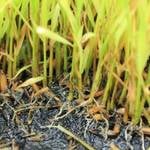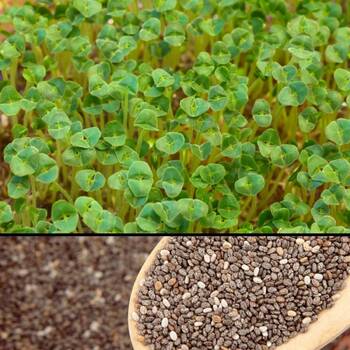
How to Grow Chia Seeds
Grow Guide #2863
Family: Lamiaceae
Binomial name: Salvia hispanica
Life Cycle: Annual
This 'How to Grow' guide details everything a home gardener needs to know to plant, grow and care for Chia (Salvia hispanica).
When to Sow Chia Seeds
Chia seeds can be grown year-round as a microgreen or plants can be grown in the garden for seed production. Use the table below to identify the best time of year to sow chia seeds in your climate.
| JAN | FEB | MAR | APR | MAY | JUN | JUL | AUG | SEP | OCT | NOV | DEC | |
|---|---|---|---|---|---|---|---|---|---|---|---|---|
| Cool | ||||||||||||
| Temperate | ||||||||||||
| Sub-Tropical | ||||||||||||
| Tropical | ||||||||||||
| Arid |
Preparation
Chia plants are best grown in full sun. Choose a location that will receive at least 6 hours of full sun each day.
Chia plants commonly self-seed in the garden. Self-seeding plants drop seeds onto the soil at the end of the season that may germinate and grow without help the following season. Choose a position where new plants will be welcome. If you do not want chia to become established in your garden, deadhead plants before they can drop seed or grow them in containers.
Chia plants need a well drained soil enriched with plenty of organic matter. Prepare soil by weeding it thoroughly, digging it over to loosen it and adding aged animal manure or compost. Keep the area free of weeds until planting. Learn more about preparing soil for planting here.
Chia plants can be grown in containers. If possible choose a variety that’s recommended for container growing. Use a good quality potting mix and make sure your container is large enough for mature plants; a minimum of 20 litres is recommended for chia. During the growing season, keep in mind that container grown plants may need additional fertiliser to encourage healthy growth.
How to Sow Chia Seeds
Chia seeds do not require any treatment (eg soaking, stratification) before sowing.
Chia seeds can be sown directly into the garden OR seedlings can be raised in trays or other containers and transplanted to the garden once established.
Sow Direct
- Sow seeds directly in the garden 3mm deep and 30cm apart, with rows 150cm apart.
- Keep soil moist but never wet or dry.
- Seeds should germinate in around 1-4 days at a soil temperature of 20-22°C.
- Young seedlings will need protection from pests, pets and weather until they are established.
Raise Seedlings
- Fill trays, punnets or jiffy pots with a good quality seed-raising mix, or use soil starter pellets.
- Sow seeds 3mm deep.
- Keep soil moist but never wet or dry.
- Seeds should germinate in around 1-4 days at a soil temperature of 20-22°C.
- Transplant seedlings to the garden once they have their first true leaves and are large enough to handle (usually 5-10cm tall).
- Plant out, spacing plants 30cm apart, with rows 150cm apart.
Chia is a tender crop that’s sensitive to frost. Do not transplant seedlings or sow seeds outside until all danger of frost has passed.
Tip: Chia seeds can also be sown in the less formal ‘scatter seed’ method. Simply roughen the soil, scatter seeds evenly over the surface, then smooth the soil over lightly to cover the seeds.
Optional: In cool climates chia seeds can be sown indoors 6 weeks before the last expected frost. Grow them in a warm position with plenty of natural light.
How to Grow Chia
Chia plants may need watering during the growing season. Water when the soil is dry about 5cm below the surface (test this by scratching away a little soil with your finger). Water deeply in the early morning or late afternoon. Avoid watering the leaves of plants to avoid fungal diseases. Learn more about watering here.
Optional: To give plants room to grow, thin seedlings when they are large enough to handle. Pull out any weak or small seedlings so plants are spaced about 30cm apart.
Chia plants will grow in nutrient-poor soils and do not need additional fertiliser during the growing season.
How to Harvest Chia
Chia should be ready to harvest in approximately 120 days.
If growing chia as a microgreen, harvest leaves once plants are 2-5cm tall by snipping the stems at ground level. Chia microgreens are best eaten soon after harvest.
If growing chia for seed, harvest the flowers when they lose their petals and start to dry. Using sharp secateurs or snips, cut fading flowers off just below the flower spike. Place the flowers in a paper bag in a dry, warm place until the flowers are completely dry. Then shake the bag to release the seeds. Remove the chaff by screening or winnowing. Chia seeds can be stored for several years in an airtight jar or container, or vacuum sealed and frozen for longer term storage.
Common Problems when Growing Chia
Like all plants, chia is susceptible to some pests, diseases and other problems. Below is a list of the most common problems gardeners encounter when growing chia plants:
 Damping off is caused by a fungal growth that transfers from the soil to seeds or tender seedlings. Seeds may appear not to germinate, or young plants start to rot when they emerge from the soil and become soft and mushy at the base before dying. Use new potting mix if raising seedlings, do not water foliage and avoid waterlogged soil. Read more about damping off here.
Damping off is caused by a fungal growth that transfers from the soil to seeds or tender seedlings. Seeds may appear not to germinate, or young plants start to rot when they emerge from the soil and become soft and mushy at the base before dying. Use new potting mix if raising seedlings, do not water foliage and avoid waterlogged soil. Read more about damping off here. Root rot is a disease caused by soil-borne fungi found in wet soil. Plants may be slow to establish, have yellowing or wilted foliage and have soft, brown tissue around the base of the stem and roots. Root rot is often fatal; remove and dispose of affected plants. Reducing soil moisture, adding organic matter to the soil and making sure mulch doesn't touch the stems of plants may help avoid root rot.
Root rot is a disease caused by soil-borne fungi found in wet soil. Plants may be slow to establish, have yellowing or wilted foliage and have soft, brown tissue around the base of the stem and roots. Root rot is often fatal; remove and dispose of affected plants. Reducing soil moisture, adding organic matter to the soil and making sure mulch doesn't touch the stems of plants may help avoid root rot.


.png)



